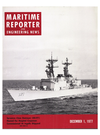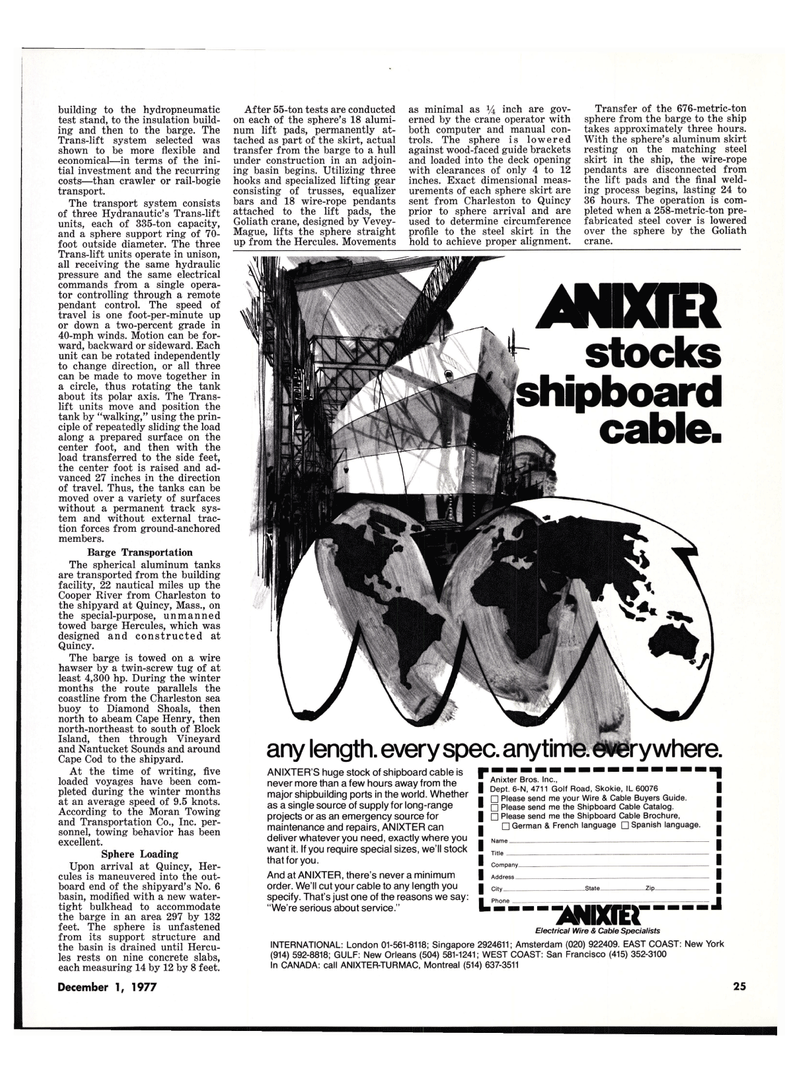
Page 23: of Maritime Reporter Magazine (December 1977)
Read this page in Pdf, Flash or Html5 edition of December 1977 Maritime Reporter Magazine
building to the hydropneumatic test stand, to the insulation build- ing and then to the barge. The
Trans-lift system selected was shown to be more flexible and economical—in terms of the ini- tial investment and the recurring costs—than crawler or rail-bogie transport.
The transport system consists of three Hydranautic's Trans-lift units, each of 335-ton capacity, and a sphere support ring of 70- foot outside diameter. The three
Trans-lift units operate in unison, all receiving the same hydraulic pressure and the same electrical commands from a single opera- tor controlling through a remote pendant control. The speed of travel is one foot-per-minute up or down a two-percent grade in 40-mph winds. Motion can be for- ward, backward or sideward. Each unit can be rotated independently to change direction, or all three can be made to move together in a circle, thus rotating the tank about its polar axis. The Trans- lift units move and position the tank by "walking," using the prin- ciple of repeatedly sliding the load along a prepared surface on the center foot, and then with the load transferred to the side feet, the center foot is raised and ad- vanced 27 inches in the direction of travel. Thus, the tanks can be moved over a variety of surfaces without a permanent track sys- tem and without external trac- tion forces from ground-anchored members.
Barge Transportation
The spherical aluminum tanks are transported from the building facility, 22 nautical miles up the
Cooper River from Charleston to the shipyard at Quincy, Mass., on the special-purpose, unmanned towed barge Hercules, which was designed and constructed at
Quincy.
The barge is towed on a wire hawser by a twin-screw tug of at least 4,300 hp. During the winter months the route parallels the coastline from the Charleston sea buoy to Diamond Shoals, then north to abeam Cape Henry, then north-northeast to south of Block
Island, then through Vineyard and Nantucket Sounds and around
Cape Cod to the shipyard.
At the time of writing, five loaded voyages have been com- pleted during the winter months at an average speed of 9.5 knots.
According to the Moran Towing and Transportation Co., Inc. per- sonnel, towing behavior has been excellent.
Sphere Loading
Upon arrival at Quincy, Her- cules is maneuvered into the out- board end of the shipyard's No. 6 basin, modified with a new water- tight bulkhead to accommodate the barge in an area 297 by 132 feet. The sphere is unfastened from its support structure and the basin is drained until Hercu- les rests on nine concrete slabs, each measuring 14 by 12 by 8 feet.
After 55-ton tests are conducted on each of the sphere's 18 alumi- num lift pads, permanently at- tached as part of the skirt, actual transfer from the barge to a hull under construction in an adjoin- ing basin begins. Utilizing three hooks and specialized lifting gear consisting of trusses, equalizer bars and 18 wire-rope pendants attached to the lift pads, the
Goliath crane, designed by Vevey-
Mague, lifts the sphere straight up from the Hercules. Movements as minimal as Vt inch are gov- erned by the crane operator with both computer and manual con- trols. The sphere is lowered against wood-faced guide brackets and loaded into the deck opening with clearances of only 4 to 12 inches. Exact dimensional meas- urements of each sphere skirt are sent from Charleston to Quincy prior to sphere arrival and are used to determine circumference profile to the steel skirt in the hold to achieve proper alignment.
Transfer of the 676-metric-ton sphere from the barge to the ship takes approximately three hours.
With the sphere's aluminum skirt resting on the matching steel skirt in the ship, the wire-rope pendants are disconnected from the lift pads and the final weld- ing process begins, lasting 24 to 36 hours. The operation is com- pleted when a 258-metric-ton pre- fabricated steel cover is lowered over the sphere by the Goliath crane.
ANIXTER'S huge stock of shipboard cable is never more than a few hours away from the major shipbuilding ports in the world. Whether as a single source of supply for long-range projects or as an emergency source for maintenance and repairs, ANIXTER can deliver whatever you need, exactly where you want it. If you require special sizes, we'll stock that for you.
And at ANIXTER, there's never a minimum order. We'll cut your cable to any length you specify. That's just one of the reasons we say: "We're serious about service."
Anixter Bros. Inc.,
Dept. 6-N, 4711 Golf Road, Skokie, IL 60076 • Please send me your Wire & Cable Buyers Guide. • Please send me the Shipboard Cable Catalog. • Please send me the Shipboard Cable Brochure, • German & French language • Spanish language.
I
I
I
I • Name ' Title • Company_ | Address
I City
Phone -Zip —ANixrer
Electrical Wire & Cable Specialists
INTERNATIONAL: London 01-561-8118; Singapore 2924611; Amsterdam (020) 922409. EAST COAST: New York (914) 592-8818; GULF: New Orleans (504) 581-1241; WEST COAST: San Francisco (415) 352-3100
In CANADA: call ANIXTER-TURMAC, Montreal (514) 637-3511 any length, every spec. jhooei ^stocks cable.
December 1, 1977 25

 22
22

 24
24
